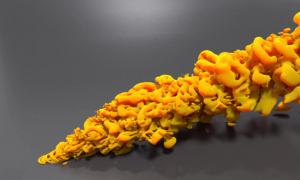Post-doctoral position in CFD: posted 20 July 2021
Development of an adaptive Hybrid RANS/LES methodology
Download the description in pdf
• Recruitment grade: young researcher (with PhD)
• Location: Pau, France
• Starting date: between October 2021 and January 2022
• Duration : 2 years
Context
The post-doc position is part of the project ASTURIES, supported by the E2S (Energy and Environment Solutions, click here to see a presentation) consortium of the university of Pau. The project is a collaboration between the Applied Mathematics Department of the university of Pau/CNRS/INRIA, where the post-doc will be working, CEA an IFPEN.
In the context of turbulent flows relevant to the many industrial sectors, the project aims at developing an innovative CFD methodology. The next generation of industrial CFD tools will be based on the only approach compatible with admissible CPU costs in a foreseeable future, hybrid RANS/LES. However, state-of-the-art hybrid RANS/LES methods (such as DES, SAS, PANS, among many others) suffer from a severe limitation: their results are strongly user-dependant, since the local level of description of the turbulent flow is determined by the mesh designed by the user.
In order to lift this technological barrier, an adaptive, or agile methodology will be
developed: the scale of description of turbulence will be locally and automatically adapted during the computation based on local physical criteria independent of the grid step, and the mesh will be automatically refined in accordance.
Objectives
The objective of this post-doc is to carry out tasks 3.2 and 4 of the ASTURIES project, as described below.
Task 3.2
Several challenging configurations will be used in the present project in order to evaluate the performance of the developed agile strategy. In order to evaluate the new strategy, reference data are necessary, obtained using state-of-the-art models and numerical methods. The purpose is two-fold: comparing the accuracy of the solutions; making sure that the CPU cost of the new strategy remains competitive. The aim of the new method is to introduce agility, i.e., a simultaneous automatic model and grid refinement, but in order to be applicable to industrial configurations in the future, the CPU cost of the method must remain comparable to the CPU cost of methods available today.
A typical state-of-the-art hybrid RANS-LES model and a typical state-of-the-art numerical method (second-order accurate finite-volume method) will be used. Therefore, the configurations selected for validation will be computed using the open-source solver Code Saturne Archambeau et al. 2004, using the standard HTLES methodology (based on a user-designed mesh, Manceau 2019 (click here to download); Duffal et al. 2021 (click here to download)).
 Figure 1: HTLES computation of the
Figure 1: HTLES computation of the
flow over a periodic hill. Q-isocontours
coloured by velocity magnitude and en-
ergy ratio in the background Duffal et al.
(2021).
Figure 2: HTLES computation of a jet in
crossflow. Q-Isocontours.
The precise list of test cases remains evolving and will be discussed by the partners during the course of the project. However, the following configurations are already envisaged:
• Backward facing-step, against experimental data (Driver and Seegmiller 1985) or DNS (Lamballais 2014).
• Supersonic base flow (Herrin and Dutton 1994).
• Flow through a square-edged orifice in a round pipe (diaphragm) (Shan et al. 2013; Benhamadouche et al. 2017).
• Jet in cross-flow configuration, which is investigated experimentally in Task 3.1.
Task 4
In collaboration with a PhD student already working on the ASTURIES project, the new adaptive hybrid RANS/LES methodology will be developed. In order to validate the different approaches developped during the project, the challenging configurations described above will be computed with this new method. The comparison of the results provided by the agile simulation on some test cases, with the corresponding CPU cost, will serve as a demonstrator of the success of the project. This will pave the way towards the dissemination of this method to our usual industrial partners in the field of aeronautic and automotive propulsion and energy production, and beyond, to all the scientific and industrial CFD communities.
Supervision and contact
The post-doc will be supervised by Remi Manceau (click here), senior CNRS researcher, specialist of turbulence modelling for CFD, working at the Laboratory for Applied Mathematics of the University of Pau.
Contact: remi.manceau@univ-pau.fr
References
Archambeau, F., N. Méchitoua, and M. Sakiz (2004). “Code Saturne: A Finite Volume Code for the Computation of Turbulent Incompressible flows – Industrial Applications”. In: Int. J. on Finite Volume, Electronical edition: http://averoes.math.univ-paris13.fr/html ISSN 1634.0655.
Benhamadouche, S., M. Arenas, and W.J. Malouf (2017). “Wall-resolved Large Eddy Simulation of a flow through a square-edged orifice in a round pipe at Re = 25,000”. In: Nucl. Eng. Des. 312, pp. 128–136.
Driver, D.M. and H.L. Seegmiller (1985). “Features of a reattaching turbulent shear layer in divergent channel flow”. In: AIAA J. 23.2, pp. 163–171.
Duffal, V., B. de Laage de Meux, and R. Manceau (2021). “Development and Validation of a new formulation of Hybrid Temporal Large Eddy Simulation”. In: Flow Turbul. Combust.
Herrin, J.L. and J.C. Dutton (1994). “Supersonic base flow experiments in the near wake of a cylindrical afterbody”. In: AIAA J. 32.1, pp. 77–83.
Lamballais, E. (2014). “Direct numerical simulation of a turbulent flow in a rotating channel with a sudden expansion”. In: J. Fluid Mech. 745, pp. 92–131.
Manceau, R. (2019). “Hybrid temporal LES: development and applications”. In: ERCOFTAC Bulletin 120, pp. 38–42.
Shan, F., A. Fujishiro, T. Tsuneyoshi, and Y. Tsuji (2013). “Particle image velocimetry
measurements of flow field behind a circular square-edged orifice in a round pipe”. In: Exp. Fluids 54.6, p. 1553.




